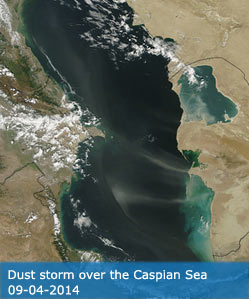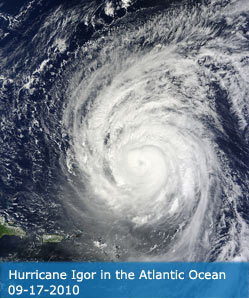Images
October 11, 2008 - Internal Waves in the Atlantic Ocean
Tweet
This image, captured by the MODIS on the Terra satellite on October 2, 2008, shows an interesting phenomenon called "internal waves". These particular waves are northeast of Brazil, out in the deep waters of the Atlantic Ocean. They are highlighted by sunglint.
Internal waves are waves that occur underwater at the boundary between layers of water with different densities. Like all major bodies of water, the Atlantic Ocean is composed of layers of water with different densities: the topmost is the least dense, while each successively deeper layer is denser.
Internal waves are usually caused by the lower layer being forced against a shallow obstacle, such as a ridge, by tidal action. The ridge causes a disturbance, which creates a wave in the water layer, similar to the way that the wind can cause waves on the water's surface. Unlike normal surface waves, internal waves can stretch for tens of kilometers in length and move throughout the ocean for several days.
Internal waves alter sea surface currents, changing the overall “sea surface roughness.” Where these currents converge, the sea surface is more turbulent, and therefore brighter because it catches more of the Sun´s reflection. Where the currents diverge, the surface is smoother and darker, creating zones called “slicks.”
Image Facts
Satellite:
Terra
Date Acquired: 10/02/2008
Resolutions:
1km ( B), 500m ( B), 250m ( B)
Bands Used: 1,4,3
Image Credit:
Jeff Schmaltz, MODIS Land Rapid Response Team, NASA GSFC
Tweet
This image, captured by the MODIS on the Terra satellite on October 2, 2008, shows an interesting phenomenon called "internal waves". These particular waves are northeast of Brazil, out in the deep waters of the Atlantic Ocean. They are highlighted by sunglint.
Internal waves are waves that occur underwater at the boundary between layers of water with different densities. Like all major bodies of water, the Atlantic Ocean is composed of layers of water with different densities: the topmost is the least dense, while each successively deeper layer is denser. Internal waves are usually caused by the lower layer being forced against a shallow obstacle, such as a ridge, by tidal action. The ridge causes a disturbance, which creates a wave in the water layer, similar to the way that the wind can cause waves on the water's surface. Unlike normal surface waves, internal waves can stretch for tens of kilometers in length and move throughout the ocean for several days.
Internal waves alter sea surface currents, changing the overall “sea surface roughness.” Where these currents converge, the sea surface is more turbulent, and therefore brighter because it catches more of the Sun´s reflection. Where the currents diverge, the surface is smoother and darker, creating zones called “slicks.”
Image Facts
Satellite:
Terra
Date Acquired: 10/02/2008
Resolutions:
1km ( B), 500m ( B), 250m ( B)
Bands Used: 1,4,3
Image Credit:
Jeff Schmaltz, MODIS Land Rapid Response Team, NASA GSFC




